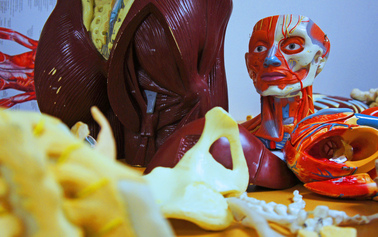Human Anatomy and Physiology Made Ridiculously Simple

Taught by Farah
Farah loves the mysteries of the human body, and she has a deep passion for sharing them with others. Though she has worked in neuroscience research at Johns Hopkins and the Bronx VA, she takes more pride in the fact that she got hundreds of people to touch real human organs at Bodies: The Exhibition. The most fun she's had in her twenties (after running around with a clipboard, poking at patients' swollen ankles and checking for corneal lesions in the Emergency Department) was teaching Anatomy and Physiology at Hunter College.
In the fall, she'll be working on a license to practice medicine, a master's in public health, and a driver's license. She's freaking out about the road test.
The human body is an awesome machine, comprised of many structures elegantly designed for their specific functions. Have you always secretly wanted to talk like Dr. House even though you never got to medical school? Been fascinated by the inner workings of the human body but were too daunted by all those Latin terms? Fear not!
What are memories? Did you know you have crystals in your ear? How do muscles get bigger? How is food converted into energy? What is the jejunum? How can you prevent your feet from swelling on an airplane? How can you use a parasitic worm to treat ulcers? Why do women retain water right before their periods? How does an egg usually prevent more than one sperm from penetrating it?
By the end of it, you'll be able to use (and correctly pronounce!) a sphymomanometer; explain a T-wave on an EKG; gently correct someone when they use the term "bad cholesterol;" give a smoker a scientifically accurate and awesomely gory description of what is happening to their lungs; and drop the phrase "microcytic, hypochromic anemia" at a party.
Learn about human anatomy and physiology from head to toe! We're going to spend three classes going over the important structures and functions of the human body.
Each of the three classes will cover a different set of organ systems, with a focus on an overarching theme. Each class can function as an independent entity, so while the class works best as a three-course unit, you don't have to take all three.
July 16: "The Communicating Body" - In Part I, we'll cover sensory systems, the nervous system, hormones, and blood. You'll learn how the body receives, interprets, and responds to messages from both the outside world and from within the body itself.
July 23: "The Moving, Breathing, Living Body" - In Part II, we'll cover musculoskeletal, respiratory, and cardiovascular systems. What does fitness mean for your muscles? For your heart? For your lungs?
July 30: "The Fundamental Needs: The Eating, Drinking, Sexing Body" - In Part III, we'll cover urinary, digestive/metabolism, and reproductive systems. Everyone loves eating and drinking and sexing, so what could be better than learning about nutrition and digestion, pregnancy, erections and peeing?
